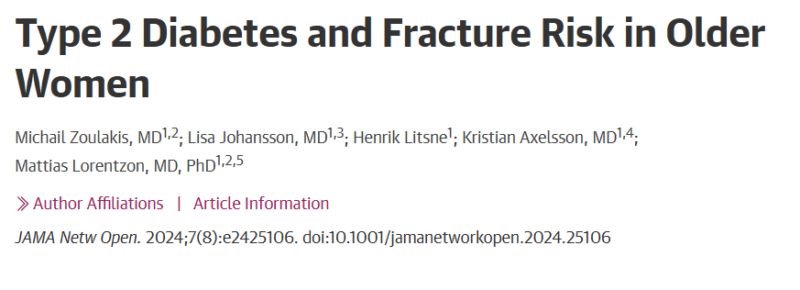Sami (Papacek) Mansfield posted on LinkedIn about recent paper by Michail Zoulakis et al., titled “Type 2 Diabetes and Fracture Risk in Older Women” published on JAMA Network.
Authors: Michail Zoulakis, Lisa Johansson, Henrik Litsne, Kristian Axelsson, Mattias Lorentzon

“The Hidden Risks of Type 2 Diabetes in Older Women How can this impact our cancer survivors?
It’s so easy to lose the forest for the trees. When I started my career in exercise oncology we were still reacting to diabetes with mostly control. We didn’t often recommend exercise and the role of skeletal muscle mass for glucose disposal was minimally used at best.
Given the increase of T2D, prediabetes, and decline in metabolic health, especially for women after cancer who are at an increased risk of bone loss, this research was such an AHA for me!
Did you know that poor physical function, not just bone density, significantly increases fracture risk in older women with Type 2 diabetes (T2DM)
In a study of 294 women with T2D (age was 78 years)
– These women had 9% higher body weight, 19% higher body mass, BUT 6.3% greater limb lean mass compared to those without T2DM!
– Despite having better bone microarchitecture—with higher bone mineral density (BMD) at the hip and lumbar spine, and stronger bones overall—physical function was globally impaired.
– Women with T2DM had 10% weaker grip strength, 10% slower walking speed, and were 14% slower to get up and start moving.
– Vitamin D levels were 7% lower in the T2DM group. Interestingly, these women were less likely to be prescribed osteoporosis medications but were more likely to use statins and antihypertensive drugs.
– Over a 7.3-year follow-up, T2DM was associated with a higher risk of other illnesses and a 27% increased overall fracture risk!
– Women on insulin had a 71% higher fracture risk and 90% higher risk of major osteoporotic fractures (MOFs)
– Physical function directly impacts fracture risk. Women with poorer physical function were 50% more likely to experience fractures, including MOFs.
– For those with poor glycemic control, the risk is even higher—women with the highest HbA1C levels faced a 2.3 to 4.6-fold increased risk of hip fractures.
What This Means:
Prolonged T2DM and insulin use, despite better bone metrics, are linked to worse physical function and higher fracture risks.
The key takeaway?
Assessment and recommendations for improving physical function are crucial in reducing fracture risk and enhancing quality of life for older women with T2DM regardless of skeletal muscle mass!”
Source: Sami (Papacek) Mansfield/LinkedIn
Sami Mansfield is the founder of Cancer Wellness for Life. She’s been a certified cancer exercise specialist since 2003 and has dedicated her career to implementing evidence-based lifestyle education, resources and tools into cancer care for both the patients and the providers. She is also a Chair of Cancer Member Interest Group, at the American College of Lifestyle Medicine and Breast Cancer Taskforce Co-Chair at Colorado Cancer Coalition.
